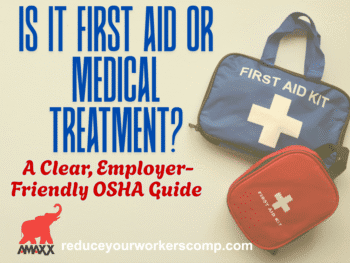
In many instances, the best time to exercise this right is the presence of red flags within a workers’ compensation claim. Identifying these danger signs is gained with experience and reading the telltale signs of an employee malingering or seeking excessive care.
- Lack of Progress and Improvement: The claim management team members review medical records received on a claim with care. It is essential to review records for signs of a healing plateau that can signal an employee is nearing maximum medical improvement (MMI) – a state where their condition cannot be improved or when a treatment plateau in a person’s healing process is reached. The IME can be used to receive a medical opinion regarding MMI and termination of ongoing wage loss benefits and medical care.
Click Link to Access Free PDF Download
“The 6-Step Process To Determine Workers’ Comp Injury Causation”
- Multiple Pre-existing Conditions: This can be a tricky area of workers’ compensation law, and employers “take the employee as they find them,” commonly called the “eggshell skull rule.” Although an employee may suffer from a pre-existing condition, any work activity aggravating or accelerating the underlying condition can be compensable. The IME should be considered to evaluate whether the employee’s condition is progressing or merely experiencing symptoms.
- Unclear Diagnosis: Treating doctors are sometimes vague regarding diagnosing the employee’s condition following a workplace incident. Examples of this include unexplained pain complaints. Other examples can include statements by the treating doctor the employee is suffering from fatigue or malaise. A diagnosis such as this indicates an IME will be needed so the defense interests have a medical opinion that will advance medical care if needed, assist in recommending further care, or provide a defense when primary liability is asserted.
- Presence of Comorbidities: A comorbidity is the simultaneous presence of two or more diseases or medical conditions in a workers’ compensation claim. Common comorbidities include cancer, high blood pressure, diabetes, or mental health issues. Comorbidities complicate questions of disability and whether the work injury is a substantial contributing factor in time off from work or additional medical care. IMEs can be used to comment on whether additional medical care is required before the treating doctor can address the work injury through invasive procedures and surgery.
- Psychological and/or Psychiatric (Mental Health) Care: These are issues of great importance in workers’ compensation claims, given the rise in jurisdictions allowing mental/mental or physical/mental injuries to be compensable. There is also the underlying fear a typical claim will morph into someone more complex. The process of any mental health condition or care should give rise to using the IME to diagnose the underlying condition and address questions related to compensability and what role the condition plays in ongoing disability.
- Permanency and Impairment Ratings: Questions related to Permanent Partial Disability (PPD) and payment of additional workers’ compensation benefits is a complex question that requires a medical professional’s review and comment. This is often the case as it requires the examining doctor to examine and take measures such as range of motion and severity of injury. All questions regarding this should be reviewed via IME if a rating received from a treating doctor appears excessive.
There are several other instances where an IME is necessary. These include excessive prescription drug use, failure of the treating doctor to respond to inquiries, and surgical claims. IMEs should only be used after obtaining a complete set of medical records and background information on the employee. It is also vital to consider the type of medical expert required to issue sound and persuasive medical opinions.
Peer Reviews Should be First Option
There are many instances where an IME is appropriate and necessary. However, in general, peer reviews should be considered the first option for obtaining physician expertise, unless an IME is strongly indicated by the above criteria.
Speed
- Peer reviews can be obtained very quickly. Depending on the nature of the review, decisions are typically available from the same-day up to 5 days from referral.
- IMEs require advance scheduling, and usually reports are not available for 10-14 days. Therefore, the handling of a claim can be expedited via peer review.
Cost
Given the great cost disparity, a peer review is often a reasonable and cost-effective initial tool, even if one ultimately may need to resort to an IME.
- From a cost perspective, peer reviews range in price from $75- $300, again varying based on the type of review.
- IMEs, on the other hand, tend to range between $300-$2000, based on provider specialty and location, and the negotiating leverage that is applied.
Conclusions
There are many instances where members of the claim management team should consider using an IME. While there is a significant cost associated with these examinations, they can help reduce overall workers’ compensation program costs and drive claims toward settlement. Now is the time to be aware of these red flags and use the IME to resolve your claims.

Contact: mstack@reduceyourworkerscomp.com.
Workers’ Comp Roundup Blog: http://blog.reduceyourworkerscomp.com/
©2023 Amaxx LLC. All rights reserved under International Copyright Law.
Do not use this information without independent verification. All state laws vary. You should consult with your insurance broker, attorney, or qualified professional.














